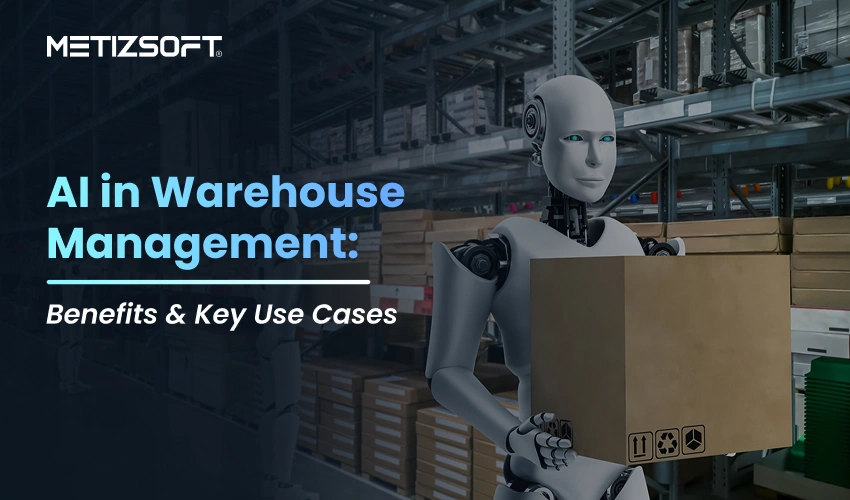
Table of Contents
Summary
Artificial intelligence is completely changing the way warehouses work. Today, businesses use smart warehouse technology AI-powered warehouse solutions and custom AI-driven warehouse management services to solve some of the biggest challenges in supply chain and logistics. With AI warehouse automation, warehouses become more accurate, productive, and scalable, enabling them to keep up with high demand and rapid growth.
Introduction
Warehouses are under immense pressure than ever due to the technological shift from manual to automation. Online shopping is booming. Customers expect fast, flawless deliveries. Hence, warehouses have to modify thousands of products, keep inventory accurate, and avoid costly mistakes. This is where artificial intelligence becomes more crucial.
By bringing smart warehouse technology and AI-driven services into the mix, businesses can boost efficiency, reduce costs, and make every process faster and smarter. From simple automations to AI-powered warehouse management platforms, even small improvements add up to massive results.
In this post, you’ll learn what AI in warehousing means, how it works, what benefits you can expect, and what’s coming next. We’ll break down real use cases, common challenges, future trends, and what you need to do if you want your warehouse to stay ahead.
AI in Warehouse Management: Key Takeaways
- Market Growth: The global AI-in-warehouse management market is set to grow at a CAGR of around 15–20%, hitting billions in value by the late 2020s.
- Real Outcomes: Companies using AI-powered warehouse solutions see inventory accuracy reach 99%, reduce labor costs by up to 30%, and experience up to 15% fewer stockouts compared to traditional systems.
- Competitive Edge: AI warehouse automation isn’t just about “robots”; it also means custom AI solutions, advanced analytics, smart sensors, and easy integrations with your existing tools.
- Opportunity for All: Whether you’re a logistics giant or a mid-sized distributor, AI can scale with your needs, thanks to flexible software and the option to hire AI developers for customized projects.
Key Metrics Table
| Metric | Value/Stat | Source |
| AI Market Growth (CAGR) | 15–26% annual through 2025-34 | Marketreserchfuture |
| Inventory Accuracy | Up to 99% with AI-powered WMS | Dexory |
| Labor Cost Reduction | 20–30% less labor spend | Meegle |
| Stockouts | 20% fewer stockouts | Omdena |
| Logistics Cost Savings | 5–20% reduction | Meegle |
Benefits of AI in Warehousing
Let’s look at the clear, practical, real-world gains that come from using AI in warehouse management.
- Order Accuracy: AI makes picking, packing, and shipping more accurate. With real-time checks and predictive analytics, warehouses see fewer mistakes. Many AI-driven businesses hit close to 99% order accuracy.
- Demand Forecasting: It’s easier to predict stock needs. AI analyzes trends and buying habits, so you order the right amount, minimizing waste and preventing out-of-stock headaches.
- Productivity: Warehouse staff and robots can work side by side. Automated task assignments and guided workflows save time and boost morale. Simple, repeatable jobs get handled by software or robots, freeing up humans for more valuable work.
- Footprint Planning: AI helps design the best use of your space. Smart slotting, virtual layouts, and real-time analytics mean you store more and move product faster without expanding your footprint.
- Fraud Detection & Loss Prevention: AI spots patterns that humans can miss, like unusual picking, repeated scanning errors, or possible theft. This means less shrinkage and tighter controls.
- Reduce Costs: By automating manual tasks, optimizing labor, and improving forecasting, companies see double-digit savings across operations.
- Enhanced Visibility: Thanks to IoT sensors and connected systems, managers get a real-time view of where everything is, so they can make fast, confident decisions.
- Scalability & Adaptivity: AI tools scale with you. As orders spike or new products roll out, smart warehouse technology adapts on the fly, with no big re-training or downtime.
AI Use Cases for Effective Warehouse Management
Here’s a look at how these AI-driven warehouse solutions actually work in day-to-day operations.
| Use Cases | Core Technology | How it Works (Key Steps) | Primary Benefits |
| Space & Layout Optimization | AI Analytics, Simulation | 1. Measure usage 2. Simulate layouts 3. Apply the best setup | Stores more Less wasted space Faster picking paths |
| Optimized Inventory Control | IoT, RFID, Analytics | 1. Track stock via sensors 2. Analyze usage 3. Auto-replenish | Fewer mistakes Lss excess Quick restock |
| AI-Powered Demand Forecasting | Machine Learning, Big Data | 1. Gather sales trends 2. Spot patterns 3. Plan inventory | Right products Right time—less waste more sales |
| Predictive Maintenance | Sensors, AI Analytics | 1. Monitor wear 2. Predict failures 3. Schedule fixes early | Fewer breakdowns Lower repair costs |
| Route Optimization | Real-Time Data, AI Routing | 1. Analyze routes 2. Replan for traffic/orders 3. Dispatch efficiently | Saves fuel Speeds up deliveries Happier customers |
| Autonomous Picking & Sorting | Robots, Vision Systems | 1. Detect orders 2. Robot picks/sorts 3. Ship | Speed Accuracy Higher output |
| Quality & Damage Control | Computer Vision, Sensors | 1. Scan shipments 2. Detect damage 3. Alert/stop | Less waste Fewer returns More trust |
Challenges & Barriers to AI Adoption
Switching to AI and smart warehouse technology brings challenges, too. Initial costs can seem high, especially for physical automation or data migration. Some teams worry about learning new systems or losing jobs. Getting buy-in from all levels (especially leaders and IT) is key to success.
Other hurdles are data privacy, making sure your old systems “talk” to new software, and keeping everything secure. Yet, with the right approach and support, companies can overcome these barriers and unlock major benefits.
Strategies for Successful Implementation of AI Warehouse
Here’s a step-by-step process on how to get started with AI warehouse management:
- Define Your Goals: Determine which tasks you want AI to assist with first, such as reducing errors or increasing order speed.
- Pick the Right Tech: Do research. See if you need ready-to-use software or custom AI solutions built by specialists.
- Build a Simple Roadmap: Outline steps to roll out new tools, test them, and make improvements.
- Run a Pilot: Test the new AI tech on a small scale. See what works and gather feedback from your team.
- Measure and Scale: Track results (like faster orders, fewer mistakes). If you see clear wins, expand the solution warehouse-wide.
If needed, hire AI developers who know warehousing; custom solutions can make a big difference for complex setups.
AI and Warehouse Management Future Trends
- Smart Robots & Wearables: Expect even more robots working side-by-side with people, and wearables (like smart gloves) helping staff track tools and orders in real time.
- Greener Warehouses: AI-powered tools cut waste and energy use, helping with both savings and meeting eco-friendly targets.
- Deeper Integrations: AI warehouses will connect with suppliers, shipping partners, and retailers, making the whole supply chain smarter.
- Generative AI: Newer systems will use generative AI to optimize schedules, simulate new layouts, and spot problems quickly.
By 2027, more than 60% of warehouses worldwide will use some form of artificial intelligence, up from just 20% in 2022.” — MHI Annual Industry Report.
Plan Successful AI Warehousing With Metizsoft
AI in warehouse management is today’s reality. Smart warehouses powered by AI are more efficient, accurate, and ready for anything. If you want to keep up and lead your industry, start exploring AI-driven warehouse management services and custom AI solutions for logistics now. Hire AI developers who understand your business challenges and make your warehouse smarter, safer, and more profitable.
Ready to take the next step? Embrace AI warehouse automation, boost efficiency, and make your operations future-proof with Metizsoft’s AI solution!
Frequently Asked Questions
Can AI work with my existing warehouse management system?
Absolutely! Most AI solutions can be integrated with older WMS or ERP systems. While some initial setup might be required, you won’t need to replace your entire system to make it work.
How long does it take to see a return on investment (ROI) with AI?
Many companies start seeing benefits, like fewer errors and faster order processing, within 12 to 24 months. Savings on labor, reduced returns, and more accurate orders all contribute to a quicker payback.
Is AI safe and secure for warehouse data?
Yes. Leading AI solutions use strong encryption and privacy controls. It’s important to work with vendors who take security seriously.
How does AI impact warehouse jobs?
AI takes over repetitive tasks, but people are still critical. Often, workers move to more creative, less physically demanding roles and help oversee the new smart technologies
AboutManthan Bhavsar
Related Posts
Payment Gateway vs Payment Processor – Sneak Peek Into Its Core Value & Advantages!
Cashless payment is the future of business! The sooner a business owner accepts this fact and adapts to cashless transactions,...
How to Hire AI Developers? Key Steps, Considerations and More
Table of Contents IntroductionAI Developers’ ResponsibilitiesKey Qualities for AI Developers to HireKey Steps to Hire...

